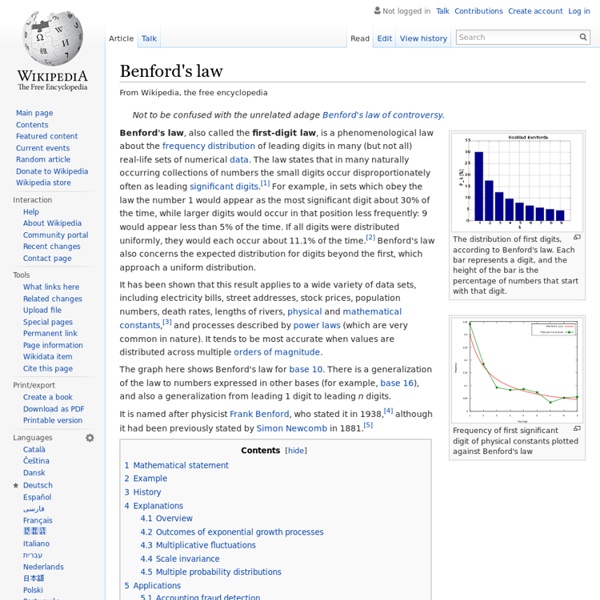Reaction Diffusion-Java
This applet displays a reaction-diffusion system. Begin exploring by using the "Preset" choice at the bottom - and the "Restart" button below it - to see some of the possible configurations. Configurable parameters include a number of manual colour-map controls (on the left) - and six main parameters of the reaction-diffusion system (on the right). Take care if using the other controls on the right. They are usually very sensitive. The model is a cellular automaton, based on the von-Neumann neighbourhood. It is based on the Gray-Scott model, and was taken from John E. More details about the type of system used can be found at the [Xmorphia web site]. Toroidial boundary constraints are appled, so the images will tesselate seamlessly. Optionally, a bumpmap technique is employed to give the images a sense of depth. Geometric note Also, the "saturated" state in the automaton is often a chequer-board pattern.
TV Wild :: Home
Rod calculus
Rod calculus or rod calculation is the mechanical method of algorithmic computation with counting rods in China from the Warring States to Ming dynasty before the counting rods were replaced by the more convenient and faster abacus. Rod calculus played a key role in the development of Chinese mathematics to its height in Song Dynasty and Yuan Dynasty, culminating in the invention of polynomial equations of up to four unknowns in the work of Zhu Shijie. Japanese counting board with grids Hardware[edit] The basic equipment for carrying out rod calculus is a bundle of counting rods and a counting board. In 1971 Chinese archaeologists unearthed a bundle of well preserved animal bone counting rods stored in a silk pouch from a tomb in Qian Yang county in Shanxi province, dated back to the first half of Han dynasty(206 BC – 8AD). Software[edit] Rod Numerals[edit] Displaying Numbers[edit] representation of the number 231 For numbers larger than 9, a decimal system is used. Displaying Zeroes[edit] 日
Nature's fireworks: the best meteor showers coming in 2015
Watching meteors in the night sky can be fun, although typically you only see a few flashes an hour. But there are certain times of the year when you can see many more – events known as meteor showers. These are caused by Earth moving through streams of debris left behind by passing comets and asteroids. Such showers are typically active for several days or even weeks, but usually feature short, sharp climaxes, or “maxima,” with their best rates being visible on just a single night. The coming year promises to be another good one for meteor buffs, so here’s a guide on what to expect and how best to enjoy nature’s own firework displays. Alpha Centaurids: maximum February 8 Click to enlarge Extending from January 28 to February 21, and peaking on February 8, this shower is known for producing brightly coloured fireballs with long-lasting trains varying from a few seconds to several minutes. This year, unfortunately, the moon will greatly hamper observations. Lyrids: maximum April 22
Earth’s Calendar Year: 4.5 billion years compressed into 12 months - Biomimicry 3.8
Life has an incredible amount to teach us about living well on planet Earth, in no small part due to the fact that it’s been thriving here for 3.85 billion years. But, how long is that really? If we take the age of Earth (4.5 billion years) and compress it into one year, we can better grasp the time-tested wisdom of our fellow planet-mates. Earth was “born” on January 1, 4.54 billion years ago. If we compress 4.54 billion years into one year, that means 144 years is 1 second. It’s not until July that multi-cellular organisms appear. Earth’s Calendar Year plainly shows our age as a species relative to the much, much older forms of life on Earth. There are 30 million other species on the planet today. There’s no guarantee that we, or any of the other species around us, will remain. Is the Earth here for us? Here’s a look at milestones worth celebrating:
Reference Pieces on Space
One interesting question about the assumptions for Euclid's system of geometry is the difference between the "axioms" and the "postulates." "Axiom" is from Greek axíôma, "worthy." An axiom is in some sense thought to be strongly self-evident. A "postulate," on the other hand, is simply postulated, e.g. Given below is the axiomatization of geometry by David Hilbert (1862-1943) in Foundations of Geometry (Grundlagen der Geometrie), 1902 (Open Court edition, 1971). I. Hilbert's Comments: If Archimedes' Axiom is dropped [non-Archimedean geometry], then from the assumption of infinitely many parallels through a point it does not follow that the sum of the angles in a triangle is less than two right angles. Hilbert's comments should serve to remind us that not only the Parallel Postulate can be denied without contradiction. Philosophy of Science, Space and Time Philosophy of Science Home Page Copyright (c) 1996, 1999, 2001 Kelley L. Three Points in Kant's Theory of Space and Time Metaphysics



